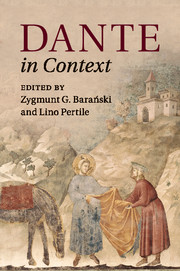Book contents
- Frontmatter
- Dedication
- Contents
- List of illustrations
- List of maps
- Notes on contributors
- Chronology
- Abbreviations and note on translations
- Introduction
- Part I Politics and society
- Part II Intellectual traditions
- Part III Linguistic and literary cultures
- 15 Linguistic Italy
- 16 Education
- 17 Rhetoric, literary theory, and practical criticism
- 18 Classical antiquity
- 19 Religious culture
- 20 Visions and journeys
- 21 Historical and political writing
- 22 Vernacular literatures
- 23 Popular culture
- Part IV Visual and performative culture
- Part V Dante: life, works, and reception
- Further reading
- Index
17 - Rhetoric, literary theory, and practical criticism
from Part III - Linguistic and literary cultures
Published online by Cambridge University Press: 05 October 2015
- Frontmatter
- Dedication
- Contents
- List of illustrations
- List of maps
- Notes on contributors
- Chronology
- Abbreviations and note on translations
- Introduction
- Part I Politics and society
- Part II Intellectual traditions
- Part III Linguistic and literary cultures
- 15 Linguistic Italy
- 16 Education
- 17 Rhetoric, literary theory, and practical criticism
- 18 Classical antiquity
- 19 Religious culture
- 20 Visions and journeys
- 21 Historical and political writing
- 22 Vernacular literatures
- 23 Popular culture
- Part IV Visual and performative culture
- Part V Dante: life, works, and reception
- Further reading
- Index
Summary
Over the last thirty years, Alastair Minnis and his collaborators have revived the study of literary criticism and theory during the Middle Ages, putting to rest prejudice that the period lacked sophisticated reflection about texts. Thanks to these scholars students of late medieval European literature have learned that in regard to literary training, canon formation, the theory of genres, practical criticism, and the dialectic of continuity and innovation, medieval writers reflected on the texts they studied and wrote chiefly through accessus (introductions to works) and by means of commentaries on matters from grammar and etymology to textual organization, authorial intention, and ideology.
The late medieval toolbox for literary theory and criticism was, if anything, overfull: manuscript culture changed slowly and retained ancient and early medieval precedents, so that critical categories multiplied. Mixing what for moderns are categories of mode or genre with those of content and intention, Conrad of Hirsau (c.1070–1150) identified nine ‘kinds’ of verse composition: bucolic, comic, tragic, satyric, lyric, apologetic, panegyric, epithalamic, epitaphic, chronical (cronicum), and elegiac, while the encyclopaedist Vincent of Beauvais (c.1190–c.1264) fused two traditional classifications to list seven species of poetry: comedy, tragedy, invective, and satire; and fable, history, and argument – something that might possibly be true (Speculum doctrinale III, 109). Indeed, late medieval paratexts deploy more than a dozen categories for characterization of written texts. First was the category of the written text itself (scriptura), which could be parsed into broad divisions: as to language (Latin or vernacular); as to whether it was verse or prose; or as to its interpretation (literal or allegorical); or according to its part of philosophy (as in understanding Ovid, the author of the Metamorphoses, as a phisicus (natural philosopher)); or according to the status of the author or writer (whether an auctor, worthy of faith, obedience, and artistic imitation, and hence an ‘authority’, an auctoritas, and thus deserving of commentary, or a mere editor, compiler, or copyist).
- Type
- Chapter
- Information
- Dante in Context , pp. 277 - 296Publisher: Cambridge University PressPrint publication year: 2015
- 11
- Cited by



